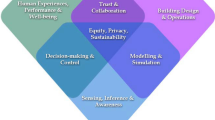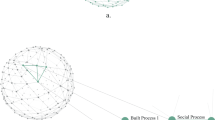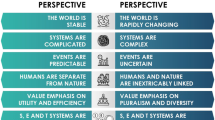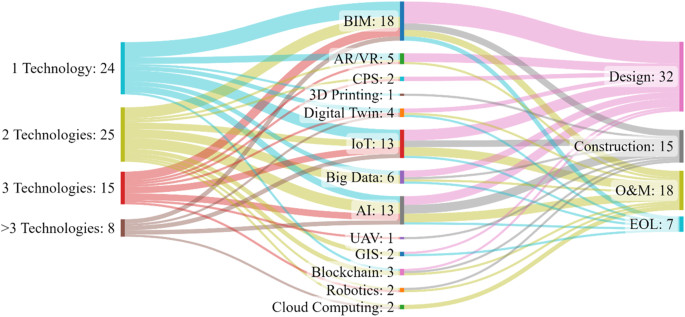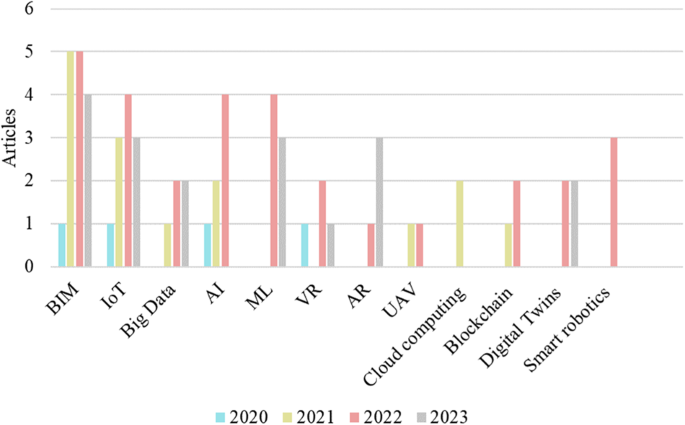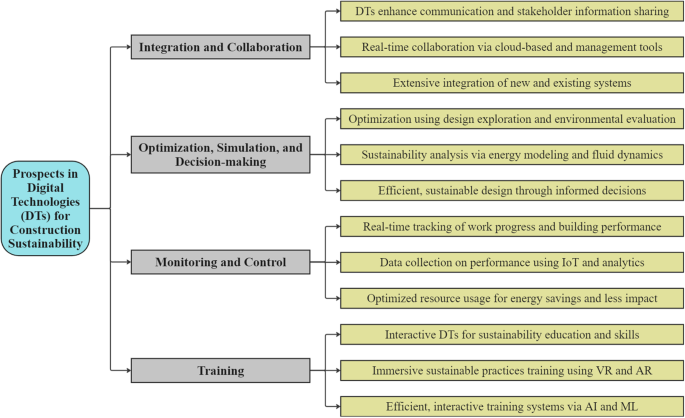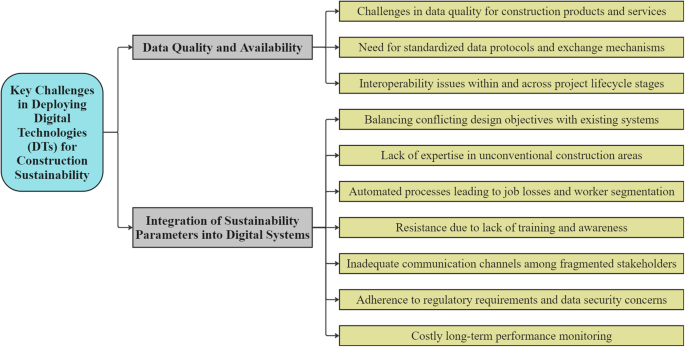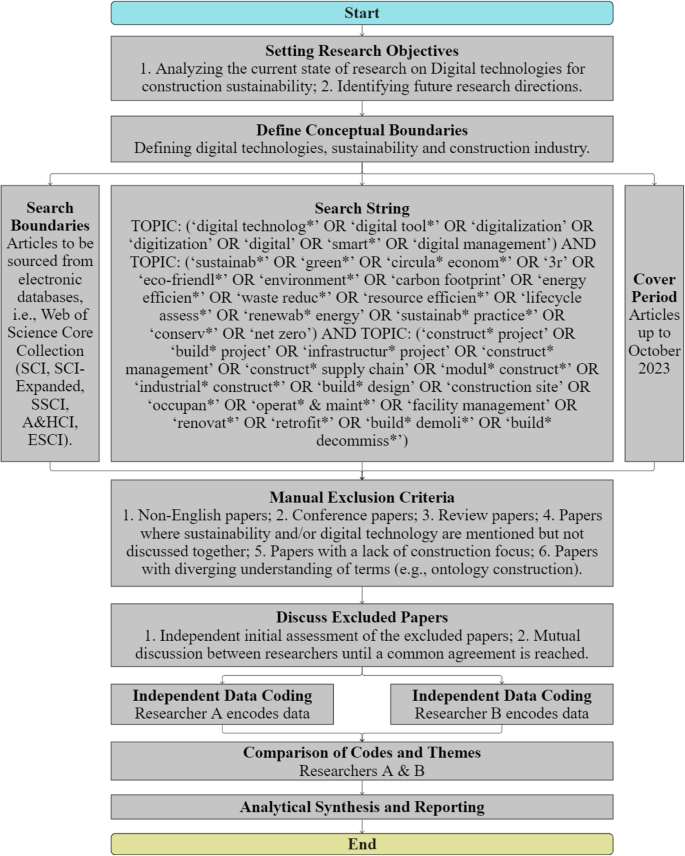Abstract
The nexus between digital technologies (DTs) and sustainability in the built environment has attracted increasing research interest in recent years, yet understanding DT utilization and its impact on construction processes remains fragmented. To address this gap, this study conducts a systematic review of the construction sustainability literature to analyze and synthesize research findings on the application of DTs at various stages of the construction lifecycle. We undertake an in-depth content analysis of 72 articles, with findings revealing that prominent DTs for construction sustainability include building information modeling, the Internet of Things, big data, and artificial intelligence. We also identify that the application of DTs for sustainability across the construction lifecycle is clustered in four areas: namely (1) integration and collaboration; (2) optimization, simulation, and decision-making; (3) tracking, monitoring, and control; and (4) training. Based on existing knowledge gaps, future research opportunities are identified, including the development of integrated and interoperable systems, long-term performance and resilience, and advanced simulation and modeling techniques. This study contributes to the literature on construction digitalization by offering a complete overview of research investigations in relation to construction sustainability and identifying research crucial to advancing a DT-enabled sustainable built environment.
Similar content being viewed by others
Introduction
The construction industry is not just about erecting buildings and infrastructure; it plays a vital role in economic and social development, contributing approximately USD200 billion to global GDP and providing over 220 million jobs1. The sector embodies a continuous lifecycle that integrates design, construction, operation & maintenance (O&M), and end of life, where each stage is interlinked and connected to the overall functionality and sustainability of the built environment2. The initial design sets the blueprint for sustainable and efficient use of resources3,4, and this design is materialized in the construction phase5. The O&M period extends over the longest phase of a structure’s life, emphasizing energy efficiency and environmental stewardship6. Finally, end-of-life is a critical component in the recycling and repurposing of materials7,8.
The construction industry has long been associated with significant environmental impacts, including resource consumption, waste generation, and carbon emissions9,10,11. It produces 45–65% of the waste dumped in landfills, contributing 35% of the world’s CO2 emissions12. As the focus of the global community on sustainable development intensifies13, the construction sector faces an imperative to evolve. Sustainable practices meet the needs of the present without compromising the ability of future generations to meet their own needs14. ‘Construction sustainability’, therefore, is the implementation of such practices in construction industry activities15, encompassing three core dimensions: environmental protection, social responsibility, and economic viability16.
In responding to sustainability challenges, digital technologies (DTs) are a potentially transformative tool. DTs include information and communication technologies (ICTs) that manage information through digital binary computer language. In construction, they range from standalone systems to integrated and web-based technologies, which aid in data capture, storage, processing, display, and communication during various procurement stages. By streamlining processes, reducing waste, and enabling better decision-making, DTs promise to significantly advance the sustainability agenda in construction.
Despite growing recognition of their potential, the academic landscape reveals a fragmented understanding of DTs’ impact on sustainability in construction. Research studies vary in focus, methodology, and findings, making it challenging for industry stakeholders to form a cohesive view of the role of DTs in promoting sustainability. This fragmentation presents a critical barrier to effectively leveraging DTs for sustainable construction practices. To bridge this knowledge gap, this study conducts a systematic review of the construction sustainability literature. The goal is to compile, analyze, and synthesize research findings to present a clear, coherent picture of how DTs are being used to foster sustainability in construction. By critically examining the interplay between DT application and sustainable practices, we aim to identify successful strategies and highlight areas urging further exploration.
Results
Prominent digital technologies in the construction sustainability literature
Reviewing the content of 72 articles in the construction sustainability literature, DTs frequently referenced and thoroughly examined were collected and organized in a Sankey diagram (see Fig. 1). Some DTs have received particular attention in the literature, e.g. building information modeling (BIM) and Internet of Things (IoT), while others have remained under-researched in relation to sustainability, e.g. unmanned aerial vehicles (UAV) and cloud computing. The diagram also reveals that DTs are employed for construction sustainability purposes mostly at the design and O&M stages of the construction lifecycle, typically as a standalone technology or paired with one other technology to achieve better performance.
Figure 2 presents the distribution in the literature of key DTs for construction sustainability from 2020 to the present. BIM is the most frequently mentioned DT in the sustainability literature, with a peak of 10 research articles published between 2021 and 2022. The results indicate the continuation of a trend, with17 identifying BIM as a top research theme in the DT-sustainability literature. This is attributable to the function of BIM as a collaborative platform and a means for integrating other DTs at different stages of the construction lifecycle. Studies relating BIM to sustainability in construction processes have seen a steady rise since the inception of BIM, with its application traversing design, construction, and O&M lifecycle stages. This suggests the vital role of BIM in improving sustainability through collaboration, visual representation, and optimization. IoT, with its use of sensors and actuators, has also been extensively discussed in the literature as essential to gathering sustainability-related data. Studies indicate the utilization of IoT in monitoring and controlling energy usage of buildings, optimizing resource use, and enhancing safety on site, all of which enable informed decisions on sustainability-related issues. Big data is also an important DT leveraging the vast amount of data generated throughout the project lifecycle by IoTs and other sources. There is a strong link between big data and IoT in the current body of knowledge, with both concepts often discussed together in optimization studies, environmental assessments, and risk and safety management. Artificial intelligence (AI) and machine learning (ML) in sustainability are gradually gaining momentum. Their ability to process huge amounts of heterogeneous data using computational power is vital for extracting insights into sustainable decision-making that effectively improves construction processes.
Other prominent DTs in construction sustainability are virtual reality (VR) and augmented reality (AR). Studies involving VR and AR cite their role in construction planning, where these DTs can be used for simulating interactive experiences and reviewing sustainability scenarios such as energy-efficient installations and user comfort. VR and AR technologies have been articulated in existing literature as early design optimization and visualization toolsets promoting a deeper understanding of sustainability features and fostering a sense of commitment towards sustainable outcomes. UAVs, or drones, are another type of DT increasingly used in construction, for surveying, inspection, and monitoring. In the construction sustainability literature, the application of UAVs has been discussed in hazard identification, safe work processes, and waste reduction. Cloud computing has also been identified as relevant to construction sustainability for its potential in providing centralized platforms for information management, communication, and collaboration throughout the project lifecycle. However, many recent studies are shifting their attention to blockchain technology as an enabler of construction sustainability, through providing transparent and immutable records and facilitating the integration of sustainable practices, such as material reuse and tracking. Little attention has been given to digital twins and cyber-physical systems (CPS) in sustainability research, though there has been an increasing trend in recent years for their potential to revolutionize construction sustainability by enabling real-time monitoring, optimization, and performance improvement throughout the project lifecycle.
Based on the results of our review of the literature, the DTs most closely associated with sustainability in the construction industry are BIM, IoT, AI, ML, VR, AR, UAV, robots, blockchain, and CPS. The overall growth in the application of these DTs for construction sustainably is likely to continue as the DT potential progressively permeates the entire lifecycle of construction products and services.
Application of digital technologies in construction sustainability
In examining the application of digital technologies to construction sustainability, it is crucial to analyze their impacts across different stages of the construction lifecycle: design, construction, O&M, and end of life.
In the design stage, recent literature indicates there is a growing nexus of DTs that enhance sustainability. Prominent examples include BIM in its 6D form, AR/VR, and AI for design. Six-dimensional BIM transcends traditional 3D modeling by integrating time (4D), cost (5D), and sustainability (6D) considerations, such as energy performance18, resource efficiency19, carbon emissions reduction20, and retrofit process simulation21. The emphasis is on the lifecycle approach22, where BIM informs decisions right from the design phase to reduce environmental impact and promote green building practices. AR/VR technologies have evolved to significantly improve design visualization and stakeholder engagement23, with discussions extending into the realm of the metaverse, which offers immersive spaces for interaction. The metaverse can benefit sustainability by facilitating the participation of the majority of people in decisions about how to utilize resources more efficiently24. AI, particularly in generative design25, is leveraged to create multiple sustainable design alternatives based on specific constraints and goals, focusing on material usage reduction26 and energy efficiency optimization27.
The construction stage sees the critical role of blockchain, IoT, radio-frequency identification (RFID), digital twins, and UAVs in advancing sustainability. Blockchain’s potential lies in enhancing transparency and accountability in construction processes28,29, while smart contracts facilitate complex agreements and compliance with sustainability standards30. They can streamline procurement processes31, enhance supply chain management32, and facilitate more efficient project management33,34, leading to reduced waste and improved resource allocation. The role of IoT in sustainable construction is growing, with a focus on real-time data collection and monitoring35. IoT devices, such as sensors and wearables, are used to track resource utilization and environmental conditions36, thus aiding in optimizing resource use and reducing energy consumption37. RFID, one of the most powerful IoT technologies, has been extensively employed for effective logistics management, deemed crucial in reducing the carbon footprint of construction activities38 by enabling accurate tracking of materials, tools, and equipment. RFID systems help in minimizing losses, reducing waste, and ensuring that materials are sourced and used sustainably. In addition, the integration of digital twins in the construction process represents a significant advancement. A digital twin is a virtual replica of a physical building that can be used for monitoring, simulation, and analysis39,40. Optimized construction efficiency is achievable through digital twins, which help streamline workflows, allocate resources efficiently, and monitor construction progress in real-time. This reduces the risks of delays and material waste by providing active and accurate information41. By creating a virtual representation of the construction project, digital twins enable a more dynamic and responsive approach to construction management, further enhancing sustainability. UAVs, commonly known as drones, are increasingly used in construction for various tasks such as site surveying, monitoring, and inspection. They provide a unique vantage point for overseeing construction activities, enabling better management of resources, and ensuring adherence to environmental and safety regulations42.
During the O&M phase, human–robot collaboration signifies a shift towards automation, enhancing efficiency and sustainability43. In this context, human–robot collaboration is not about replacing human workers, but rather enhancing their capabilities and safety44. Robots are used for tasks like cleaning, maintenance, surveillance, and inspection45, reducing the workload on human staff, increasing precision, and enhancing safety, particularly in hazardous environments. The concept of digital twins has also gained prominence in the O&M phase46. Data management and access post-construction can be complex due to the transition of control and operations among various stakeholders. This technology effectively bridges information gaps, ensuring reliable and convenient project management and facilitating enhanced communication among stakeholders41. Moreover, the digital twin provides a dynamic and real-time representation of the building and enables “what-if” analyses in occupant comfort, energy utilization, logistics optimization, asset management, and predictive maintenance, enhancing decision-making capabilities47,48,49. IoT devices and sensors, in addition, are widely used for continuous monitoring and data collection in buildings. This technology trend contributes significantly to the sustainability of facilities by enabling energy efficiency and predictive maintenance. Sensors collect data on aspects such as energy usage, temperature, and occupancy levels50,51, crucial for optimizing building operations and reducing unnecessary energy consumption52. To analyze the vast amount of data generated by IoT devices and other sources, AI and ML algorithms are increasingly applied. These technologies enable predictive maintenance, energy management, and anomaly detection, thereby enhancing the sustainability of building operations53,54.
At the end-of-life stage, DTs such as big data analytics, computer vision, robotics, and blockchain are key to managing deconstruction and waste processes. Big data analytics assists in material stock assessment, facilitating optimal material reuse and recycling, aligning with circular economy principles55,56. The role of computer vision in automating waste material sorting, combined with AI algorithms, enhances recycling efficiency57,58. Robotics in deconstruction focuses on safe material recovery59,60, while blockchain improves material traceability, ensuring informed decisions for material reuse and recycling61.
Prospects for digital technologies in construction sustainability
DTs incorporate several enhancements and modifications to construction value chain processes, increasing efficiency and productivity19. The opportunities for adopting these technologies to streamline sustainable production, construction, and operation in the industry are vast. From the analysis of the literature, we find that the driving themes in DT prospects for sustainability are linked with integration and collaboration62; optimization, simulation, and decision-making63; monitoring and control64; and training24 as presented in Fig. 3.
Integration and collaboration
The task of maintaining profitability while achieving cleaner, low-carbon construction processes, and greener and safer job sites, requires extensive stakeholder buy-in, involvement, and support65. To achieve this, there is a need to improve collaboration within and across different building lifecycles. DTs facilitate collaboration among stakeholders involved in the construction process by enabling effective communication and information sharing. According to66, cloud-based platforms, project management software, and collaborative tools allow real-time collaboration, document sharing, and coordination among architects, engineers, contractors, and sustainability consultants, among others. This collaboration enhances the integration of sustainability considerations into the project, leading to better-informed decisions and improved sustainability outcomes. Furthermore, DTs facilitate the integration of new and existing systems and processes to enhance sustainability outcomes. Integrating BIM models with energy modeling software, for instance, enables automated energy analysis and interference detection21. Integration with supply chain management systems allows for tracking and optimizing material usage, reducing waste, and promoting sustainable sourcing practices67. DTs provide a comprehensive approach to sustainability over the whole project lifecycle by combining various data sources and platforms.
Optimization, simulation and decision-making
Making informed decisions as early as feasible assists in efficient and cost-effective sustainable design and construction. Sustainability analysis tools, for example, enable better-informed decisions by analyzing numerous design options and identifying sustainable alternatives68,69. These evaluations assist professionals at various stages in determining the consequences of their building designs for environmental performance and efficiency. To improve sustainability, DTs enable optimization through the exploration of several design possibilities and evaluate their societal, environmental, and energy performance using BIM, ML, and parametric modeling. This aids in the identification of the most sustainable design solutions, decreasing material waste, energy usage, and environmental impacts70. Moreover, DTs provide simulation capabilities to assess the performance of buildings and infrastructure systems. For example, studies have incorporated energy modeling software to simulate and analyze energy consumption, daylighting, and thermal performance18. Others such as71 have used computational fluid dynamics simulations to evaluate indoor air quality, ventilation effectiveness, and natural ventilation strategies. These simulations enable designers to make informed decisions, optimize sustainability performance, and identify potential issues before construction.
Monitoring and control
Some studies have explored mechanisms for monitoring sustainable aspects such as construction-related emissions using DTs that enable real-time tracking and monitoring of work progress and building performance72. Building management systems, IoT sensors, digital twins, and data analytics platforms collect data on energy consumption, indoor environmental quality, occupancy patterns, and equipment performance. The data helps identify areas of inefficiencies, pinpoint maintenance needs, and optimize resource usage, leading to energy savings, improved occupant comfort, and reduced environmental impact73.
Training
For sustainability education and skill development, DTs provide interactive and immersive training alternatives. Immersive training experiences are made possible by VR, AR, and mixed-reality technologies, which allow users to simulate and implement sustainable construction practices, safety regulations, and energy-efficient operations24. The deployment of DTs enables safe demonstration and experimentation, promoting knowledge transfer and capacity building. Additionally, AI and ML platforms enable easy access to more efficient, responsive, and interactive train systems linked to sustainability74.
Digital technology application bottlenecks in construction sustainability
Deployment of DTs for construction sustainability faces several challenges across different stages of the project lifecycle (Fig. 4). First, accurate data and information are essential for conducting sustainability analysis during the design and planning stages of projects75. However, the present challenge of data quality and availability of construction products and services makes it difficult to fully benefit from the prospects of DT application. Data on material properties, energy consumption, and environmental impacts may not be readily available or standardized, making it difficult to assess sustainability performance accurately76. Standardized protocols, formats, and data exchange mechanisms that ensure consistent data quality and compatibility across different digital tools and platforms are still largely underdeveloped and unable to fully grasp all aspects of sustainability considerations in the construction industry. Interoperability of various DTs for holistic construction sustainability is missing within and across different lifecycle stages77. Within the same lifecycle stage, various digital tools and applications such as BIM, geographic information systems, energy modeling software, and sustainability analysis tools generate different types of data in varying formats and qualities78. Across different lifecycle stages, gathering real-time data from various sources, such as sensors and equipment, and integrating it into a unified system can be complex79. posit that the challenge lies in integrating these diverse datasets into a unified system that allows for comprehensive analysis and decision-making. Thus, ensuring data accuracy, reliability, and interoperability in different platforms and systems is crucial for enabling construction sustainability.
Another key challenge is the integration of sustainability parameters into digital systems, including balancing conflicting design objectives and ensuring compatibility with already existing systems80. The deployment of DTs for sustainable construction requires expertise in certain unconventional areas of construction and given present inadequacies in the construction workforce, such expertise is hard to find81. point to many benefits of deploying DTs for construction sustainability, including lowered employment costs for organizations through the application of automated work processes. However, this can lead to significant job losses and worker segmentation, which may in turn result in resistance to change stemming from a lack of training, awareness, and involvement. There is a need to develop innovative and varied instructional approaches, but it is unclear how these challenges faced are being addressed in the present literature80. The introduction of both DTs and sustainable practices is nascent in the construction industry but is gaining momentum. Therefore, more conscious planning and capital investment are needed to enhance industry skills and manage behavior change with necessary measures that may completely deviate from existing supply chain operations. Moreover, at the core of DT for construction sustainability is the need for stakeholder collaboration and engagement82. Yet, given the vast and fragmented nature of stakeholders along a construction project’s lifecycle, including designers, contractors, facility managers, maintenance personnel, and occupants, it can be challenging to track and foster effective collaboration. This challenge stems from the absence of efficient communication channels, unwillingness to exchange and transmit knowledge and information, and failure by the relevant parties to cultivate proactive sustainability initiatives83. Other challenges are linked to adherence to regulatory requirements and data confidence, security, protection, and issues associated with the deployment of DTs84. Given the long-term performance monitoring of sustainability features and systems over a building or infrastructure’s lifespan, the need to build trust and efficient systems is critical. Ensuring that digital systems continue to operate optimally, maintaining modern sustainable practices during renovations or retrofits, and monitoring changes in building performance require continuous data collection, analysis, and stakeholder involvement, which can be onerous and costly85.
Future research trends and directions
The findings from this critical review of trending topics, prospects, challenges, and application of DTs in promoting construction sustainability offer a full picture of current research activities and reveal relevant gaps and future research needs. These future research needs represent the untapped potential identified from the analysis and evaluation of future works proposed in the existing literature and are explained below.
-
Limited attention has been paid to the integration of DTs for sustainability in construction86. Further research is required to delve into the development of standardized protocols, formats, and data exchange mechanisms to ensure consistent data quality and compatibility across different digital tools and platforms. This includes establishing guidelines for data collection, verification, and validation to enhance the accuracy and reliability of sustainability-related data.
-
An evolving trend receiving considerable attention has been the utilization of advanced simulation and modeling techniques21. Additional study is required to enhance simulation and modeling methodologies in order to achieve more accurate forecasting and analysis of sustainability results. This encompasses the enhancement of energy modeling software, the utilization of computational fluid dynamics simulations, and the implementation of multi-scale modeling techniques to accurately represent intricate interactions and maximize the utilization of resources.
-
The application of advanced DTs including ML and AI has stimulated conversations on their anticipated threat to social aspects of sustainability. Presently, AI/ML models are used to predict sustainability performance, optimize resource allocation, and identify patterns and trends to support informed decision-making87. Though the potential of AI/ML models is much greater, the present utilization of such DTs for sustainable construction is limited. Thus, future research needs to pay attention to their impact at full potential and how risk will be managed among participants in the construction value chain.
-
The circular economy is an emerging trend in sustainability in construction and would benefit immensely from the application of DT. There is a need to develop digital tools and frameworks that support the principles of the circular economy and material optimization88. This includes exploring methods for tracking and managing material flows, assessing the environmental impact of material choices, and optimizing material usage throughout the construction lifecycle89. Present research in such areas is still nascent.
-
An obvious and reoccurring problem in sustainability research is long-term performance and assessment90. Despite the application of DTs for sustainable construction, certain inherent challenges such as system resilience and adaptability persist. Therefore, future research may focus on the extended performance and resilience of sustainable construction projects supported by DTs. This could include studying the durability and adaptability of sustainable alternatives, evaluating the performance of digital monitoring systems over extended periods, and exploring the impact of climate change and other external factors on sustainability outcomes.
-
Studies that look into knowledge-sharing mechanisms and collaboration among stakeholders are crucial and should be promoted. As suggested by Balasubramanian et al.91, future research is needed to identify effective mechanisms for sharing best practices, case studies, and lessons learned in the application of DTs for construction sustainability. This can facilitate collective learning, foster innovation, and accelerate the adoption of sustainable practices.
Implications and conclusions
This study provides an overview of current applications of DTs in promoting construction sustainability and highlights opportunities for future research and innovation. It does so by adopting a systematic literature review and content analysis to identify DTs used in relation to construction sustainability. The findings reveal BIM, IoT, and big data to have become prominent technologies over the past 5 years, with digital twins and smart robotics emerging trends in DTs for construction sustainability. The major application areas of the identified DTs are integration and collaboration; optimization, simulation, and decision-making; monitoring and control; and training. Among these application areas, DTs have been extensively researched in optimization and monitoring construction infrastructure for sustainable outcomes. The study also identifies challenges associated with DTs for construction sustainability. Key among these are technical issues of data accuracy, security, and confidence; behavioral and cultural challenges such as resistance to change among stakeholders; and financial barriers due to the high cost of implementation.
The study’s contribution lies in the provision of a holistic perspective on DTs for construction sustainability across the entire construction lifecycle. Its theoretical contribution to the sustainable construction technologies framework is to identify gaps in the existing literature and propose new directions to enable efficient deployment and implementation. It also advances knowledge of how DTs can be applied in different construction scenarios to achieve sustainable outcomes. For industry and practice, the study provides insights into challenges faced in deploying DTs for construction sustainability, enabling practitioners to anticipate and manage risks ahead of implementation. Policymakers can be informed of the landscape of DTs and their application at various stages of construction. This can guide the development of tailored policies and regulations on the efficient advancement of DTs for achieving sustainability in the industry.
Despite these contributions, the study has a few limitations. The analysis is limited to a dataset obtained only from journals in the Web of Science (WoS) database, while the selection criteria and focus on only technical articles present some limitations. While these limitations present opportunities for future research to expand the study’s findings, further studies could also examine the evolution of DTs in the built environment and their connections with sustainable development.
Methods
Bibliographic materials collection and processing
Building on the practice of conducting literature reviews within the field of construction research75,92, this study seeks to elucidate the intersections of DT and construction sustainability through a systematic literature review (SLR), designed to ensure an objective and replicable synthesis of existing research93. Such a structured approach mitigates the reliance on simplistic judgment calls, curtails the incidence of subjective inclinations and errors, and upholds the integrity of scholarly research94.
The SLR uses the consolidated steps shown in Fig. 595,96. First, it defines research objectives and conceptual boundaries to ensure a focused review; specifically, it targets the current and emergent trends of DTs in construction sustainability. Concurrently, conceptual boundaries are defined to delineate the scope of ‘digital technologies’, ‘sustainability’, and the ‘construction industry’. This dual step guarantees that the literature review remains focused and relevant. The second step involves a comprehensive search strategy and its execution. It encompasses selecting a suitable database, which, considering the nascent and interdisciplinary nature of the field, must be expansive. The WoS is apt for this purpose, encompassing a diverse range of scholarly works, including journal articles, conference proceedings, and more97. We use the WoS Core Collection, including SCl, SCI-Expanded, SSCl, A&HCI, and ESCI indices. Given the evolving terminology within DTs and sustainability in construction, a detailed search string with diverse terms is formulated and applied to the WoS database. The search is temporally bound to include articles published up to October 2023, ensuring contemporary relevance. It yields 790 articles for further processing. Subsequently, a manual exclusion process is applied, where articles are meticulously screened against predefined criteria. For instance, non-English papers, review articles, and studies that do not synergize sustainability with DT are excluded. A special plan of our SLR is the discussion of excluded papers, where an independent initial assessment by two researchers with at least 7 years of research experience is followed by a mutual discussion to reach a consensus on each paper’s exclusion. This phase ultimately narrowed down the selection to 72 articles. Following this, an independent data encoding and comparative analysis is conducted. To ensure the integrity and impartiality of data extraction, the two researchers independently read articles thoroughly and encoded data from each study. This data encompasses a variety of details, such as bibliographic information, methodologies, DTs examined, stages of concern, and their sustainability implications in construction. The independently derived datasets are compared to resolve discrepancies and to build a consensus on the themes and findings. This comparison fosters a rigorous synthesis of the literature, ensuring that the results are replicable and verifiable. Finally, an analytical synthesis is performed to summarize the current and potential future state of DT in construction sustainability.
Data availability
The datasets used and/or analyzed during the current study are available from the corresponding author on reasonable request.
References
Barbosa, F. et al. Reinventing Construction through a Productivity Revolution (McKinsey Global Institute, 2017).
Zhang, A., Yang, J. & Wang, F. Application and enabling technologies of digital twin in operation and maintenance stage of the AEC industry: a literature review.J. Build. Eng. 80, 107859 (2023).
Wang, J., Li, Z. & Tam, V. W. Critical factors in effective construction waste minimization at the design stage: a Shenzhen case study, China. Resour. Conserv. Recycl. 82, 1–7 (2014).
Bao, Z., Laovisutthichai, V., Tan, T., Wang, Q. & Lu, W. Design for manufacture and assembly (DfMA) enablers for offsite interior design and construction. Build. Res. Inf. 50, 325–338 (2022).
Sánchez-Garrido, A. J., Navarro, I. J. & Yepes, V. Multi-criteria decision-making applied to the sustainability of building structures based on modern methods of construction. J. Cleaner Prod. 330, 129724 (2022).
Beccali, M., Bonomolo, M., Ciulla, G., Galatioto, A. & Brano, V. L. Improvement of energy efficiency and quality of street lighting in South Italy as an action of Sustainable Energy Action Plans. The case study of Comiso (RG). Energy 92, 394–408 (2015).
Blengini, G. A. Life cycle of buildings, demolition and recycling potential: a case study in Turin, Italy. Build. Environ. 44, 319–330 (2009).
Bao, Z. & Lu, W. A decision-support framework for planning construction waste recycling: a case study of Shenzhen, China. J. Clean. Prod. 309, 127449 (2021).
Bao, Z., Lee, W. M. & Lu, W. Implementing on-site construction waste recycling in Hong Kong: barriers and facilitators. Sci. Total Environ. 747, 141091 (2020).
Lu, W. et al. Estimating construction waste generation in the Greater Bay Area, China using machine learning. Waste Manag. 134, 78–88 (2021).
Sev, A. How can the construction industry contribute to sustainable development? A conceptual framework. Sustain. Dev. 17, 161–173 (2009).
Lima, L., Trindade, E., Alencar, L., Alencar, M. & Silva, L. Sustainability in the construction industry: a systematic review of the literature. J. Clean. Prod. 289, 125730 (2021).
Vinuesa, R. et al. The role of artificial intelligence in achieving the Sustainable Development Goals. Nat. Commun. 11, 1–10 (2020).
Kuhlman, T. & Farrington, J. What is sustainability? Sustainability 2, 3436–3448 (2010).
Shelbourn, M. et al. Managing knowledge in the context of sustainable construction. J. Inf. Technol. Constr. 11, 57–71 (2006).
Zavadskas, E. K., Šaparauskas, J. & Antucheviciene, J. Sustainability in construction engineering. Sustainability 10, 2236 (2018).
Jin, R., Zou, Y., Gidado, K., Ashton, P. & Painting, N. Scientometric analysis of BIM-based research in construction engineering and management. Eng. Constr. Archit. Manag. 26, 1750–1776 (2019).
Gnecco, V. M., Vittori, F. & Pisello, A. L. Digital twins for decoding human-building interaction in multi-domain test-rooms for environmental comfort and energy saving via graph representation. Energy Build. 279, 112652 (2023).
Wong, J. K. W. & Zhou, J. Enhancing environmental sustainability over building life cycles through green BIM: aA review. Autom. Constr. 57, 156–165 (2015).
Gan, V. J. et al. Holistic BIM framework for sustainable low carbon design of high-rise buildings. J. Clean. Prod. 195, 1091–1104 (2018).
Mirpanahi, M. V. & Noorzai, E. Modeling the relationship between critical BIM attributes and environmental sustainability criteria using PLS-SEM technique. J. Archit. Eng. 27, 04021037 (2021).
Motalebi, M., Rashidi, A. & Nasiri, M. M. Optimization and BIM-based lifecycle assessment integration for energy efficiency retrofit of buildings. J. Build. Eng. 49, 104022 (2022).
Hajirasouli, A., Banihashemi, S., Drogemuller, R., Fazeli, A. & Mohandes, S. R. Augmented reality in design and construction: thematic analysis and conceptual frameworks. Constr. Innov. 22, 412–443 (2022).
Allam, Z., Sharifi, A., Bibri, S. E., Jones, D. S. & Krogstie, J. The metaverse as a virtual form of smart cities: opportunities and challenges for environmental, economic, and social sustainability in urban futures. Smart Cities 5, 771–801 (2022).
Buonamici, F., Carfagni, M., Furferi, R., Volpe, Y. & Governi, L. Generative design: an explorative study. Comput.-Aided Des. Appl. 18, 144–155 (2020).
Alsakka, F. et al. Generative design for more economical and environmentally sustainable reinforced concrete structures. J. Clean. Prod. 387, 135829 (2023).
Caldas, L. Generation of energy-efficient architecture solutions applying GENE_ARCH: an evolution-based generative design system. Adv. Eng. Inform. 22, 59–70 (2008).
Xu, J., Lou, J., Lu, W., Wu, L. & Chen, C. Ensuring construction material provenance using Internet of Things and blockchain: learning from the food industry. J. Ind. Inf. Integr. 33, 100455 (2023).
Lou, J. & Lu, W. Construction information authentication and integrity using blockchain-oriented watermarking techniques. Autom. Constr. 143, 104570 (2022).
Salmerón-Manzano, E. & Manzano-Agugliaro, F. The role of smart contracts in sustainability: worldwide research trends. Sustainability 11, 3049 (2019).
Li, J. & Kassem, M. Applications of distributed ledger technology (DLT) and blockchain-enabled smart contracts in construction. Autom. Constr. 132, 103955 (2021).
Li, X. et al. Blockchain-enabled IoT-BIM platform for supply chain management in modular construction. J. Constr. Eng. Manag. 148, 04021195 (2022).
Xu, J., Lu, W., Wu, L., Lou, J. & Li, X. Balancing privacy and occupational safety and health in construction: a blockchain-enabled P-OSH deployment framework. Saf. Sci. 154, 105860 (2022).
Zhao, R., Chen, Z. & Xue, F. A blockchain 3.0 paradigm for digital twins in construction project management. Autom. Constr. 145, 104645 (2023).
Rao, A. S. et al. Real-time monitoring of construction sites: Sensors, methods, and applications. Automation in Construction 136, 104099 (2022).
Lu, W., Lou, J. & Wu, L. Combining smart construction objects-enabled blockchain oracles and signature techniques to ensure information authentication and integrity in construction. J. Comput. Civil Eng. 37, 04023031 (2023).
Sajjad, M. et al. Evaluation of the success of industry 4.0 digitalization practices for sustainable construction management: Chinese construction industry. Buildings 13, 1668 (2023).
Tao, X., Mao, C., Xie, F., Liu, G. & Xu, P. Greenhouse gas emission monitoring system for manufacturing prefabricated components. Autom. Constr. 93, 361–374 (2018).
Zhao, R. et al. Comparison of BIM collaboration paradigms for digital twin readiness: centralized files, decentralized clouds and distributed blockchains. In Proc. Conference on CIB W78 (eds Kubicki, S. & Rezgui, Y.). 11–15 (International Council for Research and Innovation in Building and Construction (CIB), 2021).
Long, W., Bao, Z., Chen, K., Ng, S. T. & Wuni, I. Y. Developing an integrative framework for digital twin applications in the building construction industry: a systematic literature review. Adv. Eng. Inform. 59, 102346 (2024).
Opoku, D. G. J., Perera, S., Osei-Kyei, R. & Rashidi, M. Digital twin application in the construction industry: a literature review. J. Build. Eng. 40, 102726 (2021).
Hammad, A. W., da Costa, B. B., Soares, C. A. & Haddad, A. N. The use of unmanned aerial vehicles for dynamic site layout planning in large-scale construction projects. Buildings 11, 602 (2021).
Wu, M., Lin, J. R. & Zhang, X. H. How human-robot collaboration impacts construction productivity: an agent-based multi-fidelity modeling approach. Adv. Eng. Inform. 52, 101589 (2022).
Villani, V., Pini, F., Leali, F. & Secchi, C. Survey on human–robot collaboration in industrial settings: safety, intuitive interfaces and applications. Mechatronics 55, 248–266 (2018).
Halder, S. & Afsari, K. Robots in inspection and monitoring of buildings and infrastructure: a systematic review. Appl. Sci. 13, 2304 (2023).
Lu, Q., Xie, X., Parlikad, A. K., Schooling, J. M. & Konstantinou, E. Moving from building information models to digital twins for operation and maintenance. Proc. Institution of Civil Engineers-Smart Infrastructure and Construction. 174, 46–56 (2020).
Yitmen, I., Alizadehsalehi, S., Akıner, İ. & Akıner, M. E. An adapted model of cognitive digital twins for building lifecycle management. Appl. Sci. 11, 4276 (2021).
Petri, I., Rezgui, Y., Ghoroghi, A. & Alzahrani, A. Digital twins for performance management in the built environment. J. Ind. Inf. Integr. 33, 100445 (2023).
Chen, J., Lu, W. & Lou, J. Automatic concrete defect detection and reconstruction by aligning aerial images onto semantic‐rich building information model. Comput.‐Aided Civil and Infrastruct. Eng. 38, 1079–1098 (2023).
Wang, C. et al. Integrated sensor data processing for occupancy detection in residential buildings. Energy Build. 237, 110810 (2021).
Floris, A., Porcu, S., Girau, R. & Atzori, L. An IoT-based smart building solution for indoor environment management and occupants prediction. Energies 14, 2959 (2021).
Nesa, N. & Banerjee, I. IoT-based sensor data fusion for occupancy sensing using Dempster–Shafer evidence theory for smart buildings. IEEE Internet Things J. 4, 1563–1570 (2017).
Tien, P. W., Wei, S., Darkwa, J., Wood, C. & Calautit, J. K. Machine learning and deep learning methods for enhancing building energy efficiency and indoor environmental quality—a review. Energy AI 10, 100198 (2022).
Sanzana, M. R., Maul, T., Wong, J. Y., Abdulrazic, M. O. M. & Yip, C. C. Application of deep learning in facility management and maintenance for heating, ventilation, and air conditioning. Autom. Constr. 141, 104445 (2022).
Yuan, L., Lu, W., Xue, F. & Li, M. Building feature‐based machine learning regression to quantify urban material stocks: a Hong Kong study. J. Ind. Ecol. 27, 336–349 (2023).
Lu, W., Long, W. & Yuan, L. A machine learning regression approach for pre-renovation construction waste auditing. J. Clean. Prod. 397, 136596 (2023).
Lu, W., Chen, J. & Xue, F. Using computer vision to recognize composition of construction waste mixtures: a semantic segmentation approach. Resour. Conserv. Recycl. 178, 106022 (2022).
Chen, J., Lu, W. & Xue, F. “Looking beneath the surface”: a visual-physical feature hybrid approach for unattended gauging of construction waste composition. J. Environ. Manag. 286, 112233 (2021).
Lublasser, E., Hildebrand, L., Vollpracht, A. & Brell-Cokcan, S. Robot assisted deconstruction of multi-layered façade constructions on the example of external thermal insulation composite systems. Constr. Robot. 1, 39–47 (2017).
Lee, S., Pan, W., Linner, T. & Bock, T. A framework for robot assisted deconstruction: process, sub-systems and modeling. In 32nd ISARC: Proc. International Symposium on Automation and Robotics in Construction (ed. Fraser, S. J). (International Association for Automation and Robotics in Construction (IAARC), 2015).
Wu, L., Lu, W., Peng, Z. & Webster, C. A blockchain non-fungible token-enabled ‘passport’ for construction waste material cross-jurisdictional trading. Autom. Constr. 149, 104783 (2023).
Li, L. et al. Sustainability assessment of intelligent manufacturing supported by digital twin. IEEE Access 8, 174988–175008 (2020).
Akbarzadeh, O. et al. Heating–cooling monitoring and power consumption forecasting using LSTM for energy-efficient smart management of buildings: a computational intelligence solution for smart homes. Tsinghua Sci.Technol. 29, 143–157 (2023).
Elnour, M. et al. Performance and energy optimization of building automation and management systems: towards smart sustainable carbon-neutral sports facilities. Renew. Sustain. Energy Rev. 162, 112401 (2022).
Ababio, B. K., Lu, W. & Ghansah, F. A. Transitioning from green to circular procurement in developing countries: a conceptual framework for Ghana’s construction sector. Build. Res. Inf. 51, 798–815 (2023).
Oke, A. E., Kineber, A. F., Alsolami, B. & Kingsley, C. Adoption of cloud computing tools for sustainable construction: a structural equation modeling approach. J. Facil. Manag. 21, 334–351 (2023).
Charef, R. & Lu, W. Factor dynamics to facilitate circular economy adoption in construction. J. Clean. Prod. 319, 128639 (2021).
Kavitha, R. J. et al. Improved Harris Hawks optimization with hybrid deep learning based heating and cooling load prediction on residential buildings. Chemosphere 309, 136525 (2022).
Lou, J., Wang, B., Yuan, Z. & Lu, W. Willingness to pay for well-being housing attributes driven by design layout: evidence from Hong Kong. Build. Environ. 251, 111227 (2024).
Qiu, J. et al. Design of an evaluation system for disruptive technologies to benefit smart cities. Sustainability 15, 9109 (2023).
Bay, E., Martinez-Molina, A. & Dupont, W. A. Assessment of natural ventilation strategies in historical buildings in a hot and humid climate using energy and CFD simulations. J. Build. Eng. 51, 104287 (2022).
Zhang, E., He, X. & Xiao, P. Does smart city construction decrease urban carbon emission intensity? Evidence from a difference-in-difference estimation in China. Sustainability 14, 16097 (2022).
Wei, Y., Lei, Z. & Altaf, S. An off-site construction digital twin assessment framework using wood panelized construction as a case study. Buildings 12, 566 (2022).
Chen, Y., Huang, D., Liu, Z., Osmani, M. & Demian, P. Construction 4.0, Industry 4.0, and building information modeling (BIM) for sustainable building development within the smart city. Sustainability 14, 10028 (2022).
Qi, B., Razkenari, M., Costin, A., Kibert, C. & Fu, M. A systematic review of emerging technologies in industrialized construction. J. Build. Eng. 39, 102265 (2021).
Petrov, I. & Hakimov, A. Digital technologies in construction monitoring and construction control. In IOP Conference Series: Materials Science and Engineering, (ed. Sergeev, V.) 497, 012016 (IOP Publishing, 2019).
Yevu, S. K., Ann, T. W. & Darko, A. Digitalization of construction supply chain and procurement in the built environment: emerging technologies and opportunities for sustainable processes. J. Clean. Prod. 322, 129093 (2021).
Meng, Q. et al. A review of integrated applications of BIM and related technologies in whole building life cycle. Eng. Constr. Archit. Manag. 27, 1647–1677 (2020).
Malagnino, A. et al. Building information modeling and Internet of Things integration for smart and sustainable environments: a review. J. Clean. Prod. 312, 127716 (2021).
Wang, M., Wang, C. C., Sepasgozar, S. & Zlatanova, S. A systematic review of digital technology adoption in off-site construction: current status and future direction towards industry 4.0. Buildings 10, 204 (2020).
Love, P. E. & Matthews, J. The ‘how’ of benefits management for digital technology: from engineering to asset management. Autom. Constr. 107, 102930 (2019).
Liao, L. & Teo, E. A. L. Managing critical drivers for building information modeling implementation in the Singapore construction industry: an organizational change perspective. Int. J. Constr. Manag. 19, 240–256 (2019).
Durdyev, S., Ismail, S., Ihtiyar, A., Bakar, N. F. S. A. & Darko, A. A partial least squares structural equation modeling (PLS-SEM) of barriers to sustainable construction in Malaysia. J. Clean. Prod. 204, 564–572 (2018).
Das, M., Luo, H. & Cheng, J. C. Securing interim payments in construction projects through a blockchain-based framework. Autom. Constr. 118, 103284 (2020).
Aghimien, D. et al. Barriers to digital technology deployment in value management practice. Buildings 12, 731 (2022).
Moshood, T. D., Adeleke, A. Q., Nawanir, G., Ajibike, W. A. & Shittu, R. A. Emerging challenges and sustainability of industry 4.0 era in the Malaysian construction industry. Emerg. Chall. Sustain. Ind. 4, 1627–1634 (2020).
Pan, Y. & Zhang, L. Roles of artificial intelligence in construction engineering and management: a critical review and future trends. Autom. Constr. 122, 103517 (2021).
Antwi-Afari, P. et al. Enhancing life cycle assessment for circular economy measurement of different case scenarios of modular steel slab. Build. Environ. 239, 110411 (2023).
Bao, Z., Lu, W. & Hao, J. Tackling the “last mile” problem in renovation waste management: a case study in China. Sci. Total Environ. 790, 148261 (2021).
Zhang, Y. et al. A survey of the status and challenges of green building development in various countries. Sustainability 11, 5385 (2019).
Balasubramanian, S., Shukla, V., Islam, N. & Manghat, S. Construction industry 4.0 and sustainability: an enabling framework. IEEE Trans. Eng. Manag. 71, 1–19 (2021).
Ibem, E. O. & Laryea, S. Survey of digital technologies in procurement of construction projects. Autom. Constr. 46, 11–21 (2014).
Tranfield, D., Denyer, D. & Smart, P. Towards a methodology for developing evidence‐informed management knowledge by means of systematic review. Br. J. Manag. 14, 207–222 (2003).
Petticrew, M. & Roberts, H. Systematic Reviews in the Social Sciences: A Practical Guide (John Wiley & Sons, 2008).
Holzmann, P. & Gregori, P. The promise of digital technologies for sustainable entrepreneurship: a systematic literature review and research agenda. Int. J. Inf. Manag. 68, 102593 (2023).
Okoli, C. A guide to conducting a standalone systematic literature review. Commun. Assoc. Inf. Syst. 37, 43 (2015).
Gusenbauer, M. & Haddaway, N. R. Which academic search systems are suitable for systematic reviews or meta‐analyses? Evaluating retrieval qualities of Google Scholar, PubMed, and 26 other resources. Res. Synth. Methods 11, 181–217 (2020).
Author information
Authors and Affiliations
Contributions
W.L., J.L., and B.A. conducted the review and wrote the manuscript. R.Z., Z.B., X.L., and F.X. made suggestions and revised the manuscript. All authors read and approved the final manuscript.
Corresponding authors
Ethics declarations
Competing interests
The authors declare no competing interests.
Additional information
Publisher’s note Springer Nature remains neutral with regard to jurisdictional claims in published maps and institutional affiliations.
Rights and permissions
Open Access This article is licensed under a Creative Commons Attribution 4.0 International License, which permits use, sharing, adaptation, distribution and reproduction in any medium or format, as long as you give appropriate credit to the original author(s) and the source, provide a link to the Creative Commons licence, and indicate if changes were made. The images or other third party material in this article are included in the article’s Creative Commons licence, unless indicated otherwise in a credit line to the material. If material is not included in the article’s Creative Commons licence and your intended use is not permitted by statutory regulation or exceeds the permitted use, you will need to obtain permission directly from the copyright holder. To view a copy of this licence, visit http://creativecommons.org/licenses/by/4.0/.
About this article
Cite this article
Lu, W., Lou, J., Ababio, B.K. et al. Digital technologies for construction sustainability: Status quo, challenges, and future prospects. npj Mater. Sustain. 2, 10 (2024). https://doi.org/10.1038/s44296-024-00010-2
Received:
Accepted:
Published:
DOI: https://doi.org/10.1038/s44296-024-00010-2

